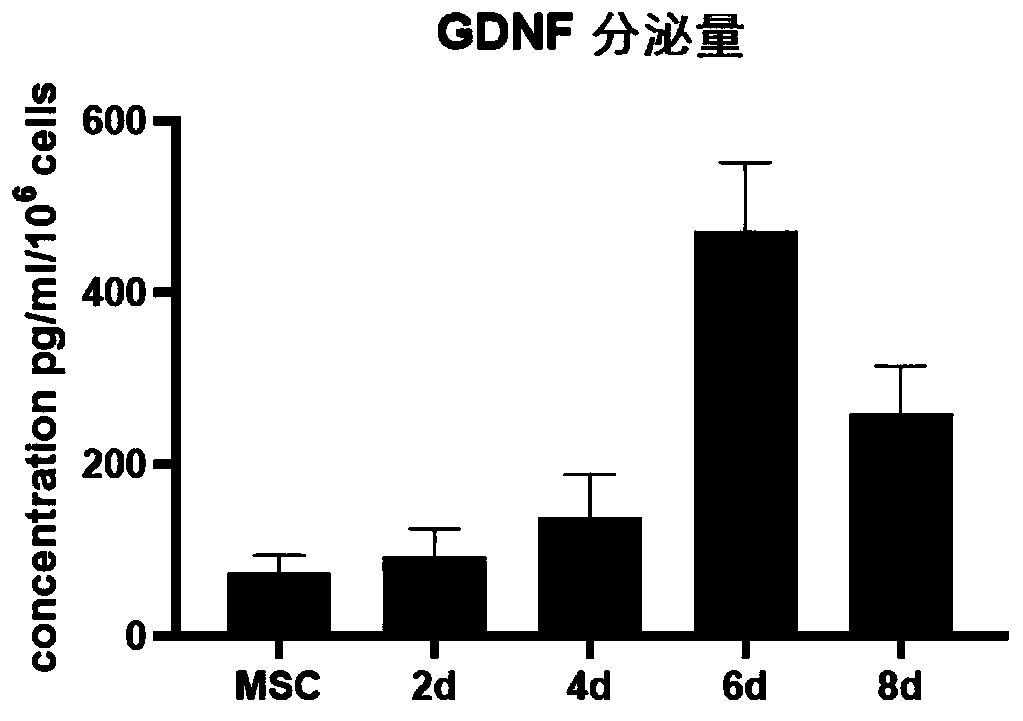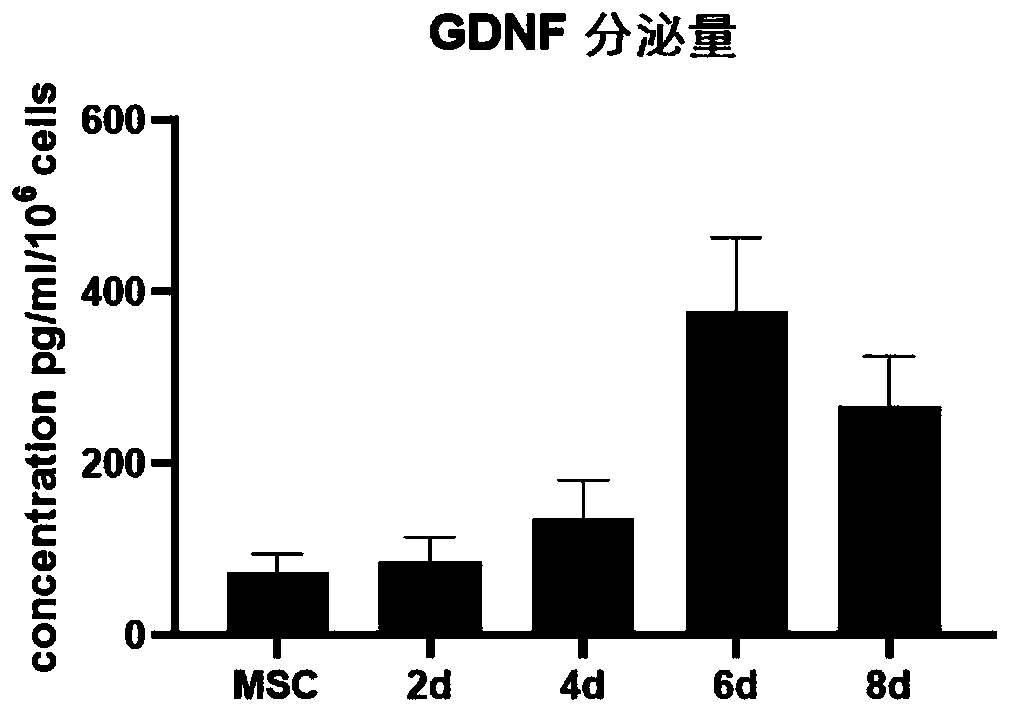Method for improving secretion of glial cell line-derived neurotrophic factors from human umbilical cord mesenchymal stem cells
A neurotrophic factor and mesenchymal stem cell technology, applied in cell dissociation methods, cell culture active agents, animal cells, etc., can solve the problem of ectopic expression of exogenous gene transfection, unclear conditioned medium composition, and difficulty in controlling the expression level and other issues, to achieve the effect of increasing secretion, safety and easy industrialization, and strong in vitro amplification ability
- Summary
- Abstract
- Description
- Claims
- Application Information
AI Technical Summary
Problems solved by technology
Method used
Image
Examples
Embodiment 1
[0033] 1. Cultivation of human umbilical cord mesenchymal stem cells
[0034] 1) Take P3~5 human umbilical cord mesenchymal stem cells, when the cells grow to 80%-90% confluence, aspirate the culture supernatant, add 10mL 0.01M phosphate buffer PBS into the T75 culture flask and wash it Abandon, a total of twice;
[0035] 2) Add 1.0 mL of 0.125% trypsin-0.01% EDTA digestion solution to the bottom of the T75 culture flask. When the cells are round and floated under an inverted microscope, add 1.0 mL of fetal bovine serum to stop trypsin digestion;
[0036] 3) Add 20mL 0.01M phosphate buffered saline PBS and repeatedly pipet and rinse, at 1000 rpm at room temperature for 5 minutes; after discarding the supernatant, add 10mL DMEM / F-12 medium (ThermoFisher Gibco TM Cat:12500096, prepared according to its instructions) resuspend the cells in a T75 culture flask according to 1~2×10 4 / cm 2 Inoculate human umbilical cord mesenchymal stem cells;
[0037] 4) The culture system is DMEM / F-12 ...
Embodiment 2
[0056] 1. Cultivation of human umbilical cord mesenchymal stem cells
[0057] 1) Take P3~5 generation human umbilical cord mesenchymal stem cells, when the cells grow to 80%-90% confluence, aspirate the culture supernatant, and add 10~15mL 0.01M phosphate buffer PBS to T75 culture flask to wash After sucking and discarding, a total of two times;
[0058] 2) Add 1.0 mL of 0.125% trypsin-0.01% EDTA digestion solution to the bottom of the T75 culture flask. When the cells are round and floated under an inverted microscope, add 1.0 mL of fetal bovine serum to stop trypsin digestion;
[0059] 3) Add 20mL 0.01M phosphate buffered saline PBS and repeatedly pipet and rinse, at 1000 rpm at room temperature for 5 minutes; after discarding the supernatant, add 10mL DMEM / F-12 medium to resuspend the cells, in a T75 culture flask According to 1~2×10 4 / cm 2 Inoculate human umbilical cord mesenchymal stem cells;
[0060] 4) The culture system is DMEM / F-12 basal medium supplemented with 10% fetal ...
Embodiment 3
[0079] 1. Cultivation of human umbilical cord mesenchymal stem cells
[0080] 1) Take P3~5 generation human umbilical cord mesenchymal stem cells, when the cells grow to 80%-90% confluence, aspirate the culture supernatant, and add 10~15mL 0.01M phosphate buffer PBS to T75 culture flask to wash After sucking and discarding, a total of twice;
[0081] 2) Add 1.0 mL of 0.125% trypsin-0.01% EDTA digestion solution to the bottom of the T75 culture flask. When the cells are round and floated under an inverted microscope, add 1.0 mL of fetal bovine serum to stop trypsin digestion;
[0082] 3) Add 20mL 0.01M phosphate buffered saline PBS and repeatedly pipet and rinse, at 1000 rpm at room temperature for 5 minutes; after discarding the supernatant, add 10mL DMEM / F-12 medium to resuspend the cells, in a T75 culture flask According to 1~2×10 4 / cm 2 Inoculate human umbilical cord mesenchymal stem cells;
[0083] 4) The culture system is DMEM / F-12 basal medium supplemented with 10% fetal bovi...
PUM
| Property | Measurement | Unit |
|---|---|---|
| molecular weight | aaaaa | aaaaa |
Abstract
Description
Claims
Application Information
 Login to View More
Login to View More - R&D
- Intellectual Property
- Life Sciences
- Materials
- Tech Scout
- Unparalleled Data Quality
- Higher Quality Content
- 60% Fewer Hallucinations
Browse by: Latest US Patents, China's latest patents, Technical Efficacy Thesaurus, Application Domain, Technology Topic, Popular Technical Reports.
© 2025 PatSnap. All rights reserved.Legal|Privacy policy|Modern Slavery Act Transparency Statement|Sitemap|About US| Contact US: help@patsnap.com



